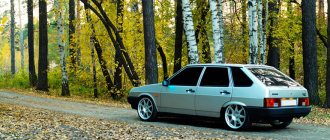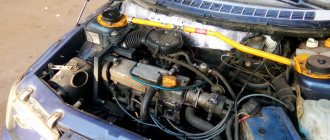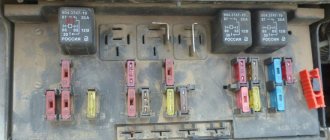There are different methods for filling the working volume of the cylinders of an internal combustion engine with a combustible mixture. Based on the principle of mixing gasoline with air, they can be divided into carburetor and injection. There are fundamental differences between them, although the result of the work is approximately the same, but there are also quantitative differences in dosing accuracy.
We will look at the advantages and disadvantages of the gasoline engine power system in more detail below.
The principle of operation of a carburetor engine
In order to create conditions for combustion in the cylinder, gasoline must be mixed with air. The atmosphere contains oxygen, which is necessary for the oxidation of gasoline hydrocarbons, releasing a large amount of heat.
Hot gases have a significantly larger volume than the original mixture, and by seeking to expand, they increase the pressure on the piston, which pushes the crankshaft and causes it to rotate. Thus, the chemical energy of the fuel is converted into mechanical energy, which drives the car.
A carburetor is needed to finely atomize gasoline and mix it with the air entering the cylinder. At the same time, the composition is dosed, since for normal ignition and combustion a fairly strict mass composition is needed.
This is interesting: What are silent blocks and why are they needed in the car suspension
To do this, in addition to the nozzles themselves, carburetors have several metering systems, each of which is responsible for a specific engine operating mode:
- main dosing;
- idle system;
- a starting device that enriches the mixture on a cold engine;
- accelerator pump that adds gasoline during acceleration;
- econostat for power modes;
- level regulator with float chamber;
- transition systems of multi-chamber carburetors;
- various economizers that regulate and limit harmful emissions.
The more complex the carburetor, the more of these systems it contains; usually they are hydraulically or pneumatically controlled, although in recent years of development electronic devices have begun to be used.
But the basic principle remains the same - the fuel emulsion, formed by the joint work of the air and fuel nozzles, is drawn into the flow of air sucked in by the pistons through the nozzles in accordance with Bernoulli's law.
Alteration of the type of fuel mixture supply
To improve a car operated in urban conditions, conversion to an injector is most suitable. The car owner will have to modify, purchase many parts and kits to achieve the result. At the preparation stage, you should have all the necessary spare parts, disassemble the front part of the car for convenient work.
Draining liquids, disassembling the carburetor, the future injection system and the fuel line are the basis for starting work; it is necessary to check the differences between the units. The VAZ power supply system is changed to an identical injection line; the cylinder head and intake manifold are replaced in most cases.
Carrying out a replacement requires certain skills, a determination of whether a carburetor or an injector is better for the car owner, as well as an approach to work. If you do not have enough experience, tools and training, you should contact specialists at a qualified car service center.
If you have any questions, watch this video, the answer to the question of what is better is a carburetor or an injector:
Features of the injection system
The main difference between injectors, or more precisely, fuel injection systems, is the supply of gasoline under pressure.
The role of the fuel pump is no longer limited to filling the float chamber, as it was in the carburetor, but has become the basis for dosing the amount of gasoline supplied through the injectors into the intake manifold or even directly into the combustion chambers.
There are mechanical, electronic and mixed injection systems, but they have the same principle - the amount of fuel per operating cycle is calculated and strictly measured, that is, there is no direct connection between the air flow speed and the cyclic gasoline consumption.
Nowadays, exclusively electronic injection systems are used, where all calculations are carried out by a microcomputer that has several sensors and continuously regulates the injection time. The pump pressure is maintained stable, so the composition of the mixture clearly depends on the opening time of the injector solenoid valves.
Summarizing
- In carburetor systems, the fuel mixture enters the engine by suction; in injection systems, it is supplied under pressure through injectors using the injection method.
- The carburetor system is unstable, but the injector is more predictable.
- The injector works equally well in any weather; the carburetor does not like temperature changes or severe frosts.
- The injector does not pollute the atmosphere as much.
- A fuel-injected car accelerates faster.
- The carburetor consumes up to 40% more fuel.
- The injector rarely breaks, but its repair is more expensive.
- The carburetor is not so demanding on the quality of gasoline.
Seal
Injector advantages
But a number of shortcomings of such sprayers gradually led to the appearance of injectors. It all started with a problem that arose in aviation, when when planes turned over or even deep banks, the carburetors refused to work normally. After all, their method of maintaining a given pressure on the jets is based on gravity, and this force is always directed downward. The pressure of the fuel injection system pump does not depend on spatial orientation.
The second important property of the injector was the high accuracy of dosing the mixture composition in any mode. The carburetor is not capable of this, no matter how complicated it was, and environmental requirements grew every year, the mixture had to burn completely and as efficiently as possible, which was also required by efficiency.
Accuracy acquired particular importance with the advent of catalytic converters, which serve to burn out harmful substances in the exhaust when poor fuel regulation leads to their failure.
The high complexity and associated decrease in system reliability was compensated by the stability and durability of electronic components that do not contain wearing parts, and modern technologies make it possible to create fairly reliable pumps and injectors.
Selecting the optimal fuel supply system
In debates about which is better - an injector or a carburetor, car enthusiasts always have differing opinions. Some people think that only the carburetor copes with the engine's operation, while others are convinced of the need to use an injector. So which of these options is the best?
It seems like an injector is the best option. Although most small engines use a carburetor system due to its simplicity and low cost, as well as lower maintenance costs, fuel injection is the ideal choice for modern vehicles to improve performance, reduce emissions and save fuel.
If power and performance are your main criteria when choosing an engine, you'll be firmly on the side of carburetors. This is due to the fact that a carburetor engine has no restrictions on the amount of fuel that can be pumped out of the tank. This means that modifications to the cam will allow more fuel to flow through the carburetor and into the cylinders. This results in a denser mixture in the chamber and higher power levels.
The only way to compete with a fuel injector is to turbocharge it to achieve the same fuel elasticity and performance. For normal daily driving, however, the extra power won't make much difference. Excess power will always lead to increased fuel consumption, which in turn will cause increased costs.
While the carburetor may have been around for over a century, the fuel injector is clearly superior in functionality and performance, delivering better power, fuel economy and lower emissions. For a modern driver, this is enough to make a choice. If you are a fan of the latest technology, then you will definitely prefer fuel injection instead of carburetor. Carburetors are old school, but that doesn't mean they're bad. Carburetors offer simplicity, whereas fuel injection is much more complex. If you're looking at a classic Mustang or vintage Chevy C10, chances are it will be equipped with a carburetor. It’s not for nothing that many old car enthusiasts would prefer to replace it with a proven carburetor instead of a new system.
Carburetor Features
The carburetor system is simpler in design and easier to maintain. An experienced motorist can independently repair its components: the carburetor and mechanical fuel pump. Repair kits for mounted units of domestic engines can be purchased at any car market and in most auto parts stores. In order to remove any of these components and replace failed parts, all you need is a simple tool, care and a little time.
The most difficult procedure in servicing a VAZ carburetor is adjusting the float and jets. This requires some experience. Adjustment of this unit is required not only after repairs and scheduled maintenance, but also quite often during operation, which causes additional trouble for car owners. However, from the point of view of most drivers, the main thing that distinguishes a carburetor from an injector is the ability to repair it yourself in any wilderness. In fact, it doesn’t matter what the engine thrust and fuel consumption will be if there is a breakdown on a trip - the main thing is to get to civilization, where you can get the necessary help.
What is the difference between an injector and a carburetor?
During the operating cycle, a saturated air-fuel mixture is formed in the carburetor, which is necessary for the engine to operate. In this case, an equal amount of mixture enters the engine, regardless of how many revolutions the “heart” of the car is operating at at a particular moment. Due to this, the system consumes a large amount of fuel and, consequently, the environment is unnecessarily polluted by exhaust gases.
When using injection systems, a lean air-fuel mixture is supplied to the engine in a dosage calculated by the central control unit. Precise dosage can significantly reduce consumption, provide cost savings and reduce the amount of harmful emissions into the atmosphere.
We recommend: Making an AUX output on your car radio yourself
The use of an injector allows in modern projects to increase engine power by up to 10%! and modernize the dynamic properties of the machine. The injector is not affected by temperature changes, it does not freeze in the cold autumn-winter period and does not overheat in the summer heat. However, the injector is more “picky” about the quality of fuel than the carburetor.
Carburetor engine
At the same time, using low-quality fuel on the carburetor is also not recommended in order to avoid serious problems with the chassis. It can be unpretentious in maintenance, compared to an injector, but only on condition that the driver fills the car with exclusively high-quality fuel. In the harsh Russian realities, such systems are subject to frequent breakdowns as a result of the use of low-quality gasoline. The advantages in such a situation include the ability to carry out repairs yourself and the affordable cost of spare parts for the unit.
The injector, on the contrary, breaks down less often and is generally more reliable, but its repair is a complex procedure. It is not possible to carry out diagnostics without special service equipment, and replacing components may require serious investment.
A number of difficulties
Owners of cars with an injector periodically encounter certain difficulties. And the most common of them is when the car starts to jerk while driving. How can we explain this behavior? If there is no reason to blame the transmission, then it is worth checking the power and ignition system. To get rid of negative consequences, it is worth checking important nodes.
Filter
Even if the fuel pump is working properly and the fuel line is clean, the engine will feel hungry if the filter is clogged. Replacing the part or thoroughly cleaning it will help correct the situation. And since the line includes as many as three filters, the first thing you should do is look for the third one, which is located behind the fuel pump.
Its purpose is to separate the smallest particles and clogs more often than others. Consequently, the pump can no longer cope with its job. Then you shouldn’t be surprised why the car jerks when driving.
Throttle
Wear of the unit, as well as contamination, including damage to parts, lead to disruption of the operation of this mechanism. In the first case, serious repairs cannot be avoided, but contamination can be dealt with by cleaning the throttle mechanically.
However, with a carburetor everything is much more complicated - you will have to completely disassemble it and clean all its elements (channels, jets, diffusers, etc.).
Fuel pump
Typically, the culprit behind the jerking of the car is the fuel pump o-ring, which is located near the valve or may be missing altogether. To make sure of this, you need to remove the cover and inspect the diaphragm along with the valve opening.
The malfunction is eliminated by replacing the damaged diaphragm and the problematic valve. After this, it is necessary to restore the tightness of the system. You should also clean the mesh that is located inside the fuel pump housing.
For injection units, the fuel pump is placed in the tank, so it is worth checking the fuel supply and whether there are losses in the line itself. To do this, you need to connect a pressure gauge to the fuel rail and record the pressure values:
- With the pump turned on, with the engine not running, it should be from 2.8 to 3.2 atm.
- When the engine is idling, 2.2-2.5 atm is considered the norm.
- When re-gassing, the values will be in the range of 2.8-3.2 atm.
Stable engine operation will be disrupted in the event of increased (more than 4 atm) or decreased (less than 2 atm) pressure inside the fuel rail.
Sensors
Any modern power plant is literally saturated with various kinds of electronics, and therefore one should not lose sight of the condition of the sensors. Violation of the TPS functionality will lead to jerks at the start. Even in a situation where the car jerks when releasing the gas, it makes sense to check this device.
Other sensors also deserve attention - mass air flow sensor, IAC (correct idle air control).
Or maybe install new valves?
New valves are not always required. Of course, if the parts are slightly curved, then you should not try to align them. The process will not give results, and you will only waste energy and time. In this case, it is better to visit a store with spare parts for vehicles and purchase a new set.
When replacing parts, special attention should be paid to their quality. The height of the valves must be the same in any case
The presence of roughness and scratches on the ends, rods and sealing working chamfers is not allowed. It is recommended to polish the parts to a shine before installing a new kit. This process must be carried out not only on the valve stems, but also on the black valve neck and on the flat plate. Thanks to this treatment, the parts will be less overgrown with soot and heat up. It is not recommended to touch the sealing chamfers during processing. They should only be ground into the saddles.
Carburetor or injector. What is more reliable in a used car?
You can often hear the authoritative opinion of old garage mechanics that cars today are not what they used to be. Although they drive faster, they do not have the same reliability and literally break down from the breeze in wet weather. Carburetor sedans that were built before 1995 are another matter. They can be repaired with a simple screwdriver and “never fail even in the most difficult situations,” so when choosing an inexpensive used car, they advise taking Soviet or German cars without complex electronic injection, which still used a carburetor-type power system. Is this really so, helps to find out the captain and engineer of the GazReid Sport sports team Vyacheslav Subbotin .
Advantages and disadvantages of the injector
Speaking about a newer model of the unit, you expect a completely different performance from it. These are more durable parts and require less cleaning time.
The VAZ 2107 injection engine outperforms its “ancient” predecessor:
- Stability of operation (this is a very important nuance; now the injector on a VAZ will run 150,000 km without any problems).
- Greater power (if you set it to seven, the power will increase by 5-10 hp).
- Durability (sensors are made completely differently, they are reliable and work without problems).
- Less fuel consumption, up to 30%.
- The operation does not depend on temperature changes (there is no need to pull out the suction valves as in the previous technology, the fuel is dosed electrically).
- Up to 75% less emissions of harmful vapors into the air.
- There is no fuel overflow when starting (if you do not start, subsequent injections will not be as active).
- There is no unpleasant odor in the cabin due to precise dosing.
About the cons:
- Complex repairs and diagnostics (if the nozzle is bent, you won’t be able to figure it out on your own).
- The presence of a large number of sensors (they can fail and become dirty, although now they are quite reliable).
- High cost of nodes.
- It is difficult to repair a broken sensor or assembly (as a rule, no one repairs them, they just replace them, but they are expensive).
- For good operation of the device, high-quality diesel fuel is required, at least 92 gasoline (the injectors have very thin injection holes, so if you fill in bad fuel, they will quickly become dirty; you need clean high-octane gasoline).
Best driving instructors:
Driving instructor Galina Manual transmission: Chevrolet Lanos Trains in Vidnoye
Driving instructor Marina Automatic transmission: Kia Cerato Manual transmission: Chevrolet LanosTeaches in the Northern Administrative District, Dolgoprudny
Automotive instructor Irina Automatic transmission: Kia Cerato Trains in North-Western Administrative District, Closed Joint-Stock Company
Driving instructor Natalya Automatic transmission: Kia Spectra Teaches in the Eastern Administrative District, Balashikha, Reutov
Driving instructor Oleg Automatic transmission: Chevrolet Lacetti Manual transmission: Chevrolet LanosTeaches in the Northern Administrative District, Dolgoprudny
Driving instructor Yana Automatic transmission: Kia Spectra Trains in Northern Administrative Okrug, Dolgoprudny
Driving instructor Yulia Automatic transmission: Chevrolet Lacetti Manual transmission: Chevrolet LanosTrains in the Eastern Administrative District, South-Eastern Administrative District, Lyubertsy, Reutov, Zheleznodorozhny
Automotive instructor Svetlana Automatic transmission: Chevrolet Lacetti Trains in Northwestern Administrative District
Driving instructor Tatyana Manual transmission: Chevrolet Lanos Automatic transmission: Kia SpectrTeaches in Krasnogorsk
Automotive instructor Peter Manual: Daewoo Nexia Trains in Northwestern Administrative District
Driving instructor Oksana Automatic transmission: Hyundai Accent Manual transmission: Chevrolet LanosTeaches in North-Eastern Administrative District, Mytishchi, Korolev, Pushkin
Driving instructor Dmitry Automatic transmission: Volkswagen Golf Manual transmission: Chevrolet Lanos Trains in North-East Administrative District, Northern Administrative District, North-Western Administrative District, Dolgoprudny
Driving instructor Oksana Automatic transmission: Kia Spectra Manual transmission: Chevrolet Lanos Trains in the Southern Administrative District, South-Western Administrative District, Vidnoye, Podolsk
Driving instructor Ekaterina Automatic transmission: Hyundai Accent Manual transmission: Daewoo Nexia Trains in North-Western Administrative District, Northern Administrative District, Khimki, Dolgoprudny
Automotive instructor Dmitry Manual transmission: Lada Granta Trains in the South-Eastern Administrative District, Lyubertsy
Source
Pros and cons of injection machines
When choosing gasoline cars with injectors installed in the fuel supply system, the car owner receives the following advantages over analogues:
- with an equal working volume to carburetor analogues, the power of an injection engine will be approximately 10% higher;
- optimal method of gasoline injection;
- the ignition angle is set as accurately as possible;
- a special collector design is used.
In addition to efficiency, drivers note the easy start of the car even during frosts. There is no need for a long warm-up to get off to a fast start. The high degree of reliability is due to the absence of a distributor, which is often the culprit of problems in gasoline cars.
The disadvantages of this design are:
- difficulty of self-repair;
- high fuel requirements;
- high cost of replacing spare parts.
The negative aspects are compensated by a long, high-quality period of operation.
How to distinguish an injection car from a carburetor
If you know what a carburetor looks like, then all you have to do is open the hood and look under it. But if you have no idea about it, then a number of signs will help you identify it:
- a new car sold at a car dealership is 100% fuel-injected;
- look at the nameplate at the rear of the car - for example, it says BMW 525i. This “i” is the designation of an injection car;
- year of car manufacture. Injectors began to be installed on foreign cars in the mid-90s, on domestic ones - from the beginning of the 2000s;
- The air filter housing is mounted directly on the carburetor. If you see air ducts (for example, black plastic corrugated boxes), then most likely you have an injection machine in front of you;
- If the indicators that light up on the dashboard when you turn the key contain a “Check Engine” indicator, then the car in front of you is fuel-injected.
Source
Advantages and disadvantages of a carburetor
If we consider the advantages of a carburetor engine, we can highlight:
- Simple design (consists of a tank, tube, line, filter, pump and carburetor).
- Cheap and easy repair.
- Easily accessible and inexpensive spare parts for it.
- Low requirements for fuel quality (once again you can save money by filling with diesel).
- Simplified diagnostics (if everything works fine, a simple cleaning is enough).
- There are no large number of electronic sensors (the only sensor works in tandem with the float, indicating the fuel level).
Of the minuses:
- Low stability of operation (after traveling 5,000 km you will have to clean the part).
- Difficult to fine-tune (unless you understand everything about it, it’s impossible to install it yourself).
- Great dependence on temperature changes (the needle may freeze, frozen to the body, and the car will not start).
- High fuel consumption.
- Large emissions of harmful gases and vapors (no electronic control).
- Filling the spark plugs (we didn’t start the car a couple of times - the spark plugs broke).
- Unpleasant smell in the cabin.
- It is difficult to rev up the engine and get it to full power.
- The fuel pump needs to be changed every 10,000 km (it clogs very quickly).
What should you pay attention to?
To carry out repairs, you need to have a general understanding of electricity and its properties. If with mechanical breakdowns everything is much simpler and often a visual inspection is enough to detect a part that needs replacement, then with electrical faults there is no such clear visualization. Moreover, the initial cause of generator breakdowns may be a malfunction of another component of the VAZ 21074, for example, the same battery. And vice versa. Very often a chain reaction is detected, with damage to several nodes.
As mentioned earlier, you cannot check the operation of the generator on the VAZ 21074 using the old method of tilting the terminals. Don't forget about the injector and ECU.
It is better not to buy a used generator, but to buy a new one. But even in this case, you need to check the voltmeter readings and battery charging more often than usual. Alas, even new factory products are sometimes defective. Therefore, it is better to play it safe, thereby protecting all electronics, injector, battery and other devices from overvoltage
This is really important
If you don’t have confidence in your abilities, then it’s better to immediately contact a workshop. And one more important detail. If any element installed in the generator fails, service centers first of all offer its complete replacement rather than partial replacement. Of course, this approach has its advantages, but when the warranty period has expired, it is very expensive.
The housing of the voltage regulator unit becomes very hot during operation. You need to keep the wires away from it.
To regularly monitor fluctuations in voltage and battery charge level, you can purchase an on-board computer that includes a similar function. In addition, this will be useful for many other components of the VAZ 21074. Such a device is indispensable on cars where an injector is installed.











